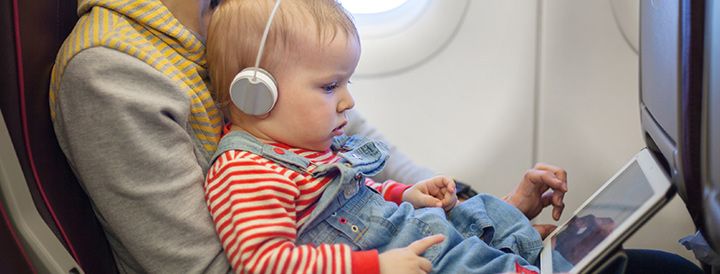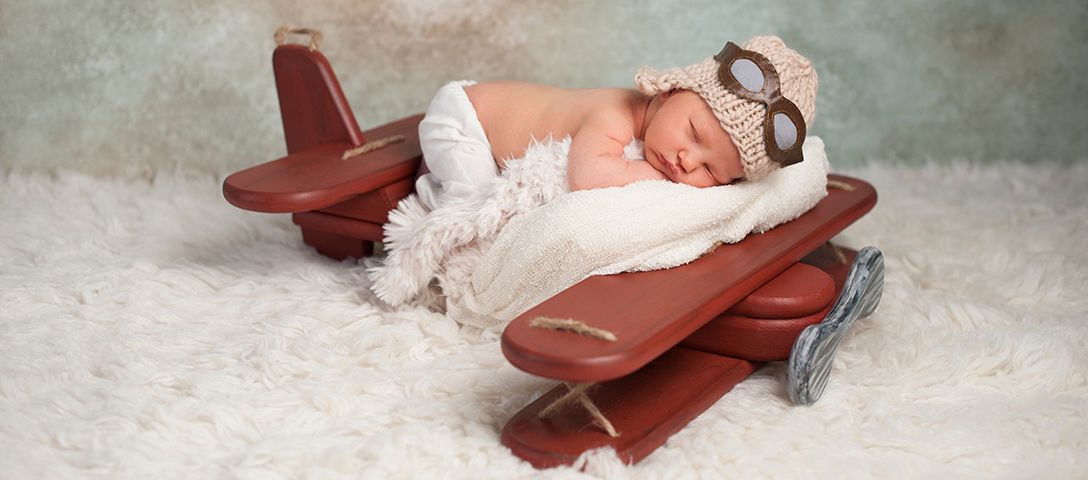Taking a baby on a plane is a sensitive topic, as many parents fear of flying with their precious little ones. You should know that your baby is out of danger if he's older than two weeks when you decided to bring him on a flight. But that doesn't mean that your flight would be as usual.
If you came across this topic, then you already know the toughness of the situation when you are stuck 30,000 feet above the ground in a flying metal tube with a crying baby. In fact, it is such a common occurrence, that it’s surprising that people still find this situation unacceptable and highly stressful. Babies are just like us, and while we, grown-ups, hold a strong emotional command, these tiny people - don't.
A child is a special person who needs maximum attention and care, anywhere and anytime. You may think that dealing with a crying baby on planes might differ from how you would do it at home, but there is no major distinction between the two.
We’ve prepared some useful advice about traveling by plane with a newborn or an infant, and we’ll shed some light on what to do when your baby is crying while aboard.

Know Your Baby
There are several reasons why your baby is crying, fussing, or screaming, and the first piece of advice we want to give you is to know your child’s behavior. When your baby starts crying, act fast, and determine the motive of his upset. Is your baby hungry or thirsty? Is your child bored or uncomfortable? Is he in pain? Acting fast can guarantee a happy baby in no time, and less stress and discontent among passengers. Subsequently, just apply the same strategies of bringing back the happiness to your child that you have already tested at home.
Don’t Worry About the Others
No matter what reason caused your baby to cry, we know that you’re trying your best to soothe your precious one. It is becoming worse when you see or hear other passengers getting stressed about the situation. But you shouldn’t be bothered about it. Do what you got to do, pay maximum attention to your baby, and make him happy again. When talking about a baby crying for no reason, you should be prepared for any unforeseen turns. It may happen to anyone, so you should stay calm and try distracting your baby’s attention. Cross your fingers, this may actually work.
If you feel too uncomfortable about bothering the fellow passengers, consider bringing with you some additional foam earplugs and offering them to anyone who is irritated. Being anxious about your baby crying is not the best thing you could do for yourself or your baby. Stay as content as possible, and your baby will eventually calm down, as he feels your every emotional change.
Preserve Your Baby’s Schedule as Unchanged as Possible
It’s always handy to get a plan and get prepared for a plane ride with your little one. Think about the scenario when your baby would get inconsolable, and make a plan, how would you bring joy to him. It is not the best option to postpone your baby’s nap, or his feeding time, in order to keep him occupied during the flight with meals and snacks. Keep his schedule as usual, as it is not the best to board a plane with an overly-tired and hungry baby.
Keep Your Baby Entertained During the Flight

It is essential to distract the baby's attention while cruising the friendly skies, as he might get bored. If you want to read a magazine, go ahead, and page it with your little one. You can make a game out of it by pointing and naming the objects on the pages. You can surprise your baby by bringing out of your carry-on a new toy or other interesting things. He will be delighted to inspect it and play with it, and this will keep him entertained for a period of time.
Feed Your Baby During the Initial Climb and the Descent of the Plane
It is typical for a baby to cry when the plane is taking off or landing. Due to pressure change in the cabin, adults and babies can feel ear discomfort or even pain. Babies don’t know how to swallow voluntarily, thus, to ease your baby’s distress, nurse, or feed him from the bottle. A pacifier can work, too, if the baby won’t eat. Don’t forget to keep it in your carry-on. The ascension and descent take about 20 minutes. During this time, try your best to make it through.
Keep Your Baby Hydrated and Use Medications If Needed
If you didn’t know, on a plane, the air is highly dry. The perfect humidity of the air recommended to be in a baby’s room is about 40-60%. There's only 20% of it, onboard. So, you can already imagine how hard it is to breathe for a baby up there. If the baby caught a cold and he has snot, the dry air can transform them into boogers. Imagine how hard breathing this way may actually be for him. By using saline sprays or drops, you will be able to clean his nose, and the baby will manage to breathe without any issues. Make sure to give your baby plenty of water, in order to prevent his throat from getting dry.
Bounce Your Baby
If your baby started crying, you could soothe him by walking the aisle back and forth. Bounce your baby while strolling the aisle, but if it’s not possible to do it, then keep your baby upright on your shoulder, and bounce him. Hopefully, your crying baby will be a sleeping baby eventually.
Bring Additional Diapers, Clothes, Blankets, and Snacks
As breast milk and baby formula are not subjected to TSA’s 3:1:1 Rule, you are allowed to bring more than you think you would need. You wouldn’t be happy to run out of food for your baby. The same applies to clothes for you and your baby, blankets, and diapers. There are plenty of unforeseen events that may occur. So, it is much better to be prepared for anything, than regretting about leaving something behind.
Don’t Forget Your Baby’s Security Items
If your baby got attached to a specific item, then do not forget to bring it with you. Whatever it is: a blankie, a binky or a stuffed toy, these are the things to carry for baby in flight, for sure. Pack the item of affection in your carry-on that is not held in the overhead compartment. When your baby starts crying, you will be thankful that you have easy access to it.
For Those Who See a Crying Baby on Plane

Flying with a baby is not always easy and as pleasant as you would think. If you’ve encountered a crying baby while aboard, you wouldn’t want to make the situation worse. Believe it. The parents would like to be anywhere else, just like you. The best advice that we can give is to do nothing about it, as the parents know how and what to do in this situation. But it is up to you if you want to offer them some help. Even a smile or a kind word can put the parent’s mind to ease a bit. If there is no help needed, put foam earplugs, listen to some music, or watch a movie.
If you sit in an aisle seat, you can offer it to a parent who is flying with an infant on lap. It can make a big difference for a parent with a crying baby who is sitting in the middle seat. This way, he will have extra shoulder room to hold his little one. Also, it will be easier to stand up and stroll the aisle of the plane, hoping that his baby will stop crying.
Remember: it might be the baby's first flight, and he might be scared. Either flying with a 2-month-old baby or a 2-year-old toddler and no matter what caused the baby to cry, you don’t have another choice but to face this situation and reconcile.
Flying with a newborn or an infant can be tricky sometimes. Unexpected occurrences may happen, and you should be prepared for them. A crying baby is a common thing on a plane, and the best thing you can do is to please his needs and understand his behavior. We hope that you find these tips for flying with a crying baby useful, and we wish you to have an easy and peaceful flight with your baby!
Last Updated on September 23, 2019.

